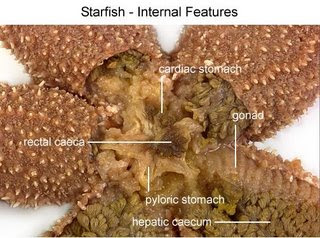Circulatory system
Circulation occurs in three places: the perivisceral coelom (basically, the space inside the body but outside the various organs), the water vascular system (of which the tube feet are the most obvious part), and the hemal system (which actually looks something like a circulatory system). The hemal system is shown below. There are hemal channels forming rings around the central part of the body around the mouth (the oral hemal ring), closer to the upper surface (the aboral hemal ring), and a third ring around the digestive system (the gastric hemal ring). These are connected by the axial sinus. There are also radial hemal channels running down the rays next to the gonads (which are also located in the rays). A dorsal sac attached to the axial sinus pulsates, sort of like a very inefficient heart (inefficient because it lacks a one-way valve system). The hemal system seems mostly organized to distribute nutrients from the digestive tract.The water vascular system uses cilia and the constant contraction of ampulla (to extend and retract the tube feet) also helps keep things moving. There is an ionic imbalance that causes water to flow into the water vascular system through the madreporite, and then the Tiedemann's bodies divert some of it into the perivisceral coelom. Circulation in the perivisceral coelom is mostly by ciliary beating.
Nervous system
Echinoderms have rather complex nervous systems, but lack a true centralized brain. All echinoderms have a network of interlacing nerves called a nerve plexus which lies within as well as below the skin. The esophagus is also surrounded by a number of nerve rings which send radial nerves that are often parallel with the branches of the water vascular system. The ring nerves and radial nerves coordinate the starfish's balance and directional systems. Although the echinoderms do not have many well-defined sensory inputs, they are sensitive to touch, light, temperature, orientation, and the status of water around them. The tube feet, spines, and pedicellariae found on starfish are sensitive to touch, while eyespots on the ends of the rays are light-sensitive.
Integumentary
Most starfish have five arms, but some have more or fewer. Some starfish have shown differing numbers of limbs within a single species. The mouth is located underneath the starfish on the oral or ventral surface, while the anus is located on the top of the animal. The spiny upper surface is called the aboral or dorsal surface. On the aboral surface there is a structure called the madreporite, a small white spot located slightly off-center on the central disc which acts as a water filter and supplies the starfish's water vascular system with water to move. Porcellanasteridae employ additional cribriform organs used to generate current in the burrows made by these infaunal starfish.
Excretory system
A echinoderm has a simple excretory system.
Reproductive system
Starfish are capable of both sexual and asexual reproduction. Individual starfish are male or female. Fertilization takes place externally, both male and female releasing their gametes into the environment. Resulting fertilized embryos form part of the zooplankton. Starfish are developmentally embryologically known as deuterostomes. Their embryo initially develops bilateral symmetry, indicating that starfish probably share a common ancestor with thechordates. Later development takes a very different path however as the developing starfish settles out of the zooplankton and develops the characteristic radial symmetry. Some species reproduce cooperatively, using environmental signals to coordinate the timing of gamete release; in other species, one to one pairing is the norm.
Body Plan
Starfish radiate diversely in shapes and colors, the morphology differing between each species. Starfish have a simple photoreceptor eyespot at the end of each arm. The eye is only able to register differences of light and dark, which are useful in detecting movement.The star fish have two stomachs. One stomach is used for digestion, and the other stomach can be extended outward to engulf and digest prey. This feature allows the starfish to hunt prey that is much larger than its mouth would otherwise allow. Starfish are able to regenerate lost arms. A new starfish may be regenerated from a single arm attached to a portion of the central disk.
Digestive System
Starfish have a complete digestive system with a mouth at the center of their underside (the "oral" side) and an anus on their upper surface (the "aboral" side).Food can be brought into the stomach through the mouth or, in many species, the cardiac stomach can be extended out through the mouth to digest food outside the body. Suspension-feeding starfish use their tube feet to pass food to the mouth. The cardiac stomach is connected to a pyloric stomach (located above it), which in turn is connected to both the anus and to the pyloric ducts and pyloric cecum which extend out into each arm.The pyloric ceca (or digestive glands) and the cardiac stomach produce digestive enzymes. Digested material is absorbed through the pyloric ceca for transport to the rest of the body.
Habit
Sea star live in tropical coral reefs, kelp forests to deep-sea floor, although none of them live within the water column; all species of starfish found are living as benthos.
Diet
Starfish eat clams and oysters or any animal too slow to evade the attack (e.g. dying fish). Some species are detritivores, eating decomposed animal and plant material or organic films attached to substrate. The others may consume coral polyps (the best-known example for this is the infamous Acanthaster planci) , sponges or even suspended particles and planktonsp
Distinguishes
Starfish are members of the phylum Echinodermata. This is because the skeleton is not rigid, as in the case of echinoids sea urchins,but is composed of many small plates (or ossicles) which quickly fall apart and are scattered after death and the decay of the soft parts of the creature.
- http://images.google.com/images
- http://sps.k12.ar.us/massengale/starfish _dissection.htm








No comments:
Post a Comment